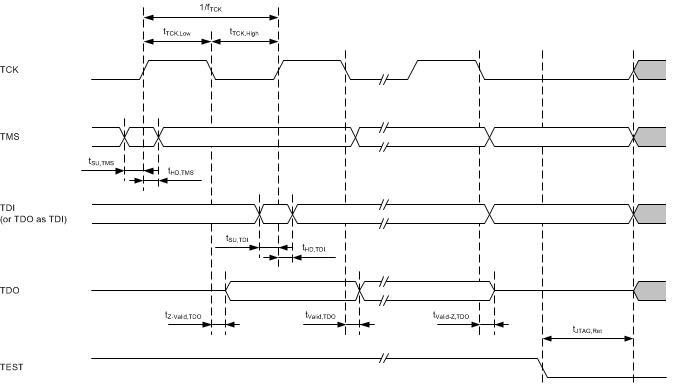SLASEE5D January 2018 – January 2021 MSP430FR2422
PRODUCTION DATA
- 1 Features
- 2 Applications
- 3 Description
- 4 Functional Block Diagram
- 5 Revision History
- 6 Device Comparison
- 7 Terminal Configuration and Functions
-
8 Specifications
- 8.1 Absolute Maximum Ratings
- 8.2 ESD Ratings
- 8.3 Recommended Operating Conditions
- 8.4 Active Mode Supply Current Into VCC Excluding External Current
- 8.5 Active Mode Supply Current Per MHz
- 8.6 Low-Power Mode (LPM0) Supply Currents Into VCC Excluding External Current
- 8.7 Low-Power Mode (LPM3, LPM4) Supply Currents (Into VCC) Excluding External Current
- 8.8 Low-Power Mode (LPMx.5) Supply Currents (Into VCC) Excluding External Current
- 8.9 Typical Characteristics - Low-Power Mode Supply Currents
- 8.10 Typical Characteristics – Current Consumption Per Module
- 8.11 Thermal Resistance Characteristics
- 8.12 Timing and Switching Characteristics
-
9 Detailed Description
- 9.1 Overview
- 9.2 CPU
- 9.3 Operating Modes
- 9.4 Interrupt Vector Addresses
- 9.5 Bootloader (BSL)
- 9.6 JTAG Standard Interface
- 9.7 Spy-Bi-Wire Interface (SBW)
- 9.8 FRAM
- 9.9 Memory Protection
- 9.10
Peripherals
- 9.10.1 Power-Management Module (PMM)
- 9.10.2 Clock System (CS) and Clock Distribution
- 9.10.3 General-Purpose Input/Output Port (I/O)
- 9.10.4 Watchdog Timer (WDT)
- 9.10.5 System (SYS) Module
- 9.10.6 Cyclic Redundancy Check (CRC)
- 9.10.7 Enhanced Universal Serial Communication Interface (eUSCI_A0, eUSCI_B0)
- 9.10.8 Timers (Timer0_A3, Timer1_A3)
- 9.10.9 Hardware Multiplier (MPY)
- 9.10.10 Backup Memory (BAKMEM)
- 9.10.11 Real-Time Clock (RTC)
- 9.10.12 10-Bit Analog-to-Digital Converter (ADC)
- 9.10.13 Embedded Emulation Module (EEM)
- 9.11 Input/Output Diagrams
- 9.12 Device Descriptors
- 9.13 Memory
- 9.14 Identification
- 10Applications, Implementation, and Layout
- 11Device and Documentation Support
- 12Mechanical, Packaging, and Orderable Information
Package Options
Refer to the PDF data sheet for device specific package drawings
Mechanical Data (Package|Pins)
- PW|16
- RHL|20
Thermal pad, mechanical data (Package|Pins)
Orderable Information
8.12.10.2 JTAG, 4-Wire Interface
over recommended ranges of supply voltage and operating free-air temperature (unless otherwise noted) (see Figure 8-19)
| PARAMETER | VCC | MIN | TYP | MAX | UNIT | |
|---|---|---|---|---|---|---|
| fTCK | TCK input frequency(1) | 2 V, 3 V | 0 | 10 | MHz | |
| tTCK,Low | TCK low clock pulse duration | 2 V, 3 V | 15 | ns | ||
| tTCK,High | TCK high clock pulse duration | 2 V, 3 V | 15 | ns | ||
| tSU,TMS | TMS setup time (before rising edge of TCK) | 2 V, 3 V | 11 | ns | ||
| tHD,TMS | TMS hold time (after rising edge of TCK) | 2 V, 3 V | 3 | ns | ||
| tSU,TDI | TDI setup time (before rising edge of TCK) | 2 V, 3 V | 13 | ns | ||
| tHD,TDI | TDI hold time (after rising edge of TCK) | 2 V, 3 V | 5 | ns | ||
| tZ-Valid,TDO | TDO high impedance to valid output time (after falling edge of TCK) | 2 V, 3 V | 26 | ns | ||
| tValid,TDO | TDO to new valid output time (after falling edge of TCK) | 2 V, 3 V | 26 | ns | ||
| tValid-Z,TDO | TDO valid to high-impedance output time (after falling edge of TCK) | 2 V, 3 V | 26 | ns | ||
| tJTAG,Ret | Spy-Bi-Wire return to normal operation time | 15 | 100 | µs | ||
| Rinternal | Internal pulldown resistance on TEST | 2 V, 3 V | 20 | 35 | 50 | kΩ |
(1) fTCK may be restricted to meet the timing requirements of the module selected.
 Figure 8-19 JTAG 4-Wire Timing
Figure 8-19 JTAG 4-Wire Timing